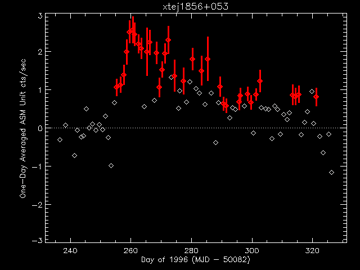RXTE Discoveries
RXTE Discovers New Transient In Galactic Ridge - November 1996
Dr. Frank Marshall and his collaborators, Drs. Ken Ebisawa and Azita Valinia at NASA/Goddard and Dr. Ron Remillard at MIT, have announced the discovery of the first new transient X-ray source seen by RXTE. This object, near the border of the constellations Aquila and Serpens Cauda, was detected during scans by the Proportional Counter Array (PCA) of the Galactic Ridge on September 17 and 18. The new source, dubbed XTE J1856+053, had an X-ray flux (in the 2-10 keV energy range) of about 6 % of the intensity of the Crab nebula on each of five scans taken during that time. Re-analysis of data from RXTE's All Sky Monitor (ASM) showed that the source was first detected on September 10, peaked during September 15-17, then gradually dimmed to about 0.7% of the Crab on October 31.
Dr. Marshall and his collaborators are studying the origin of X-ray emission from the disk of our galaxy near its center, an area known as the Galactic Ridge. They are testing the hypothesis that this diffuse emission arises from the interactions of cosmic rays with the interstellar medium. Their study consists of a series of scans along the Ridge using the PCA on RXTE. However, in addition to the diffuse emission, there are many known X-ray binary systems in this region. Dr. Marshall takes account of these by comparing the locations of large increases in X-ray intensity along the scan with a catalogue of known X-ray sources. For the scans taken in mid-September, however, he noticed an increase in X-ray intensity at a location not in the catalogue. Using the known properties of the PCA's field of view, Drs. Ebisawa and Valinia pinpointed the location of the source to an uncertainty of 0.03 degrees. Because of the relative faintness of this new source, it initially went undetected in RXTE's All Sky Monitor. But by re-analyzing the ASM data, Dr. Remillard saw that the ASM initially detected it on Sept 10.
Below is a plot prepared by Derek Fox (MIT) of the X-ray intensity of XTE J1856+053 as observed by the RXTE ASM. The open white diamonds indicate data in which detection of the source was not certain. Data points in red, with the error bars, are true detections of the source. Note that day 260 of 1996 is Sept. 16.

About 40 transient X-ray sources have been observed in the more than three decades of X-ray astronomy. The first was discovered independently by teams from the U.S. and Australia in the spring of 1967. These sources become bright in X-rays for a few weeks or a few months, and then fade from view. Some transients have been seen only once, while others have had repeated brightenings every few years. The X-rays arise from the vicinity of a neutron star or a black hole. The sudden appearance of the object in X-rays is due to mass transfer from a nearby companion star. The cause of this sudden mass ejection is the real mystery. Some X-ray transients have massive companions known as Be stars, which rotate very rapidly and occasionally eject material from their equator. Other transients have less massive companions (with masses more like our Sun), and the sudden outburst may be due to either an instability in the stellar companion or in the disk of material surrounding the X-ray source. Often, the appearance of these transients allows the mass of the X-ray source to be determined. In recent years, a number of black hole candidates have been identified from such studies of X-ray transients.
Whether XTE J1856+053 is a neutron star or a black hole will take further observations. Because this source was not noticed until Dr. Marshall and his collaborators examined their data after the observation itself, very little is known about this object. Astronomers will watch, wait, and hope for another outburst.


